Hsipaw, where we crawled off the train from Mandalay, is the gateway for those who want to trek Shan State. It’s a glorious location, set amidst mountains, agricultural areas, and tea plantations, perfect and a little cooler at altitude. Here’s our experiences of our Trek in Shan State, Myanmar.
THIS POST MAY CONTAIN COMPENSATED AND AFFILIATE LINKS MORE INFORMATION IN OUR DISCLAIMER
EASIEST WAY TO HIKE SHAN STATE
This fabulous trip takes you from Yangon all the way to the stunning Northern Shan State – where you’ll visit local villages, hike through the jungle and explore. Your accommodation is includd, food and your English speaking guide, you’ll end your trip in Mandalay.
We met our guide Sawmmy at our hotel in Hsipaw. We arrived here on a long overdue train from Mandalay, which took us over our bucketlist item of crossing the Gokteik Viaduct on the train. After a decent nights sleep we met Sawmmy, (pronounced Sawn-ming) and he’s been our guide for the last two days, after our intro from the Lily Home Hotel in Hsipaw.
He regularly demonstrated that he likely has Nepali ancestors as he describes what our route would be like in this one night, two day trek from Hsipaw in the Shan State. It’s exactly the same style used by our guide on our trek to Everest Base Camp in Nepal, to describe a “downhill”. Which usually means flat, or up a little. And he’s usually using this description to spur us on as we head up another hill.
We’ve come here to Shan State more on a whim than anything else. Or rather there was food involved. After our icky introduction to Burmese cuisine we ended up eating at a Mandalay restaurant patronized by many more locals than tourists – Shan MaMa, which turned out to be one of the highlights of our visit to Mandalay.
Suffice to say, we changed our entire plans as a result of those meals in Mandalay.
Trekking with a Guide in Shan State
Sawmmy has lived here all his life. He’s been a tour guide for more than 20 years. His son is Mitch Michael, who’s Facebook page I’d found and thought that he would also be great to trek with.
Sawmmy’s grandmother worked for Mr Brown, who ran a plantation here back in the day. It’s from her that he learned his English and his love of the knife, fork and spoon to eat food with.
We met Sawmmy and our two fellow Brits, Chris and Ellen at 08:00. We set off in a tuk-tuk to the outskirts of Hsipaw, where we pick up the trail.

Details of our Trek in Shan State
Our first day of trekking is around 20 kilometes mostly uphill. The second day is 18 kilometers mostly downhill. It’s because our route has us heading to a small hill village where we’ll spend the night. Then we’ll turn around and taking a slightly different route we’ll head back to Hsipaw.
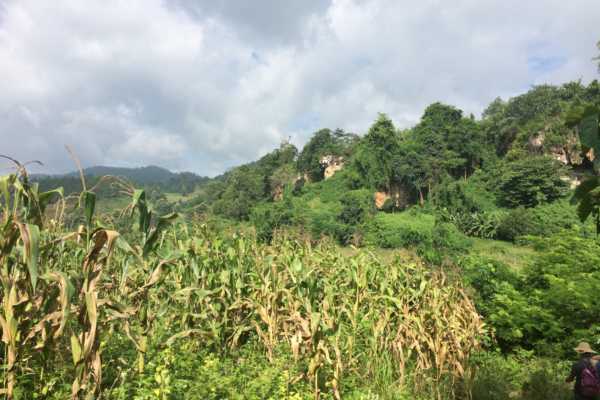
Sawmmy also offers three, four, and five day trekking options. There are normal, advanced and hard core options in his repertoire. We’re on advanced apparently, the normal being a day trek. It costs us 25,000 kyat (US$19.38 – although you do NOT need US dollars to pay for it) each, because there are four of us, this includes our lunch and dinner on the first day, breakfast on the second day and a bed to sleep in on our overnight.

We set off uphill, through fields – rice and vegetable and the occasional banana tree.
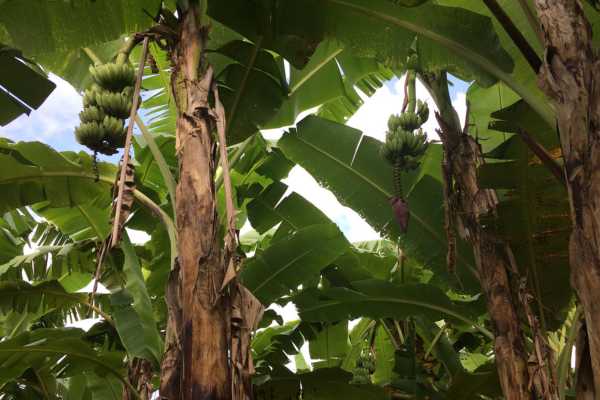
The walking isn’t difficult, the trail is easy throughout the trek – we were lucky with dry weather and as we gained altitude it cooled nicely.

The sun, though, especially on the second day as we descended back into the heat was brutal and I had to resort to trekking with my umbrella!
We stop for brief respite mid morning – in a bamboo hut where a cute kitten entertains and where we snack on freshly picked pomelo (which I’d last had with Belinda in Xinjie, China).
There are also snails on offer , but we stick to fruit.

Sawmmy is a good guide. He tells us about the local area, we talk about economics of the region of the crops growing here and then when we want to go on ahead at a faster pace he lets us until we need his guidance as to a left, right or straight on.

Lunch is at 13:30 in a small village, in what looks like the village shop.
Some trekkers will stay here the night on shorter treks (it does feel like we’ve hardly got going at this point, so it must be a much shorter route!).
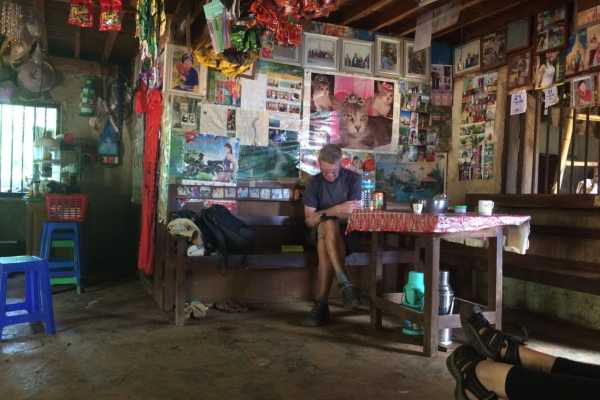
And it’s delicious – a buffet style selection of fresh dishes with endless steamed rice.

Now, says Sawmmy, we rest and leave at 15:00. And it’s here that we’re first introduced to the laid back bamboo chair, which if I ever have a space to call my own again, I’ll invest in several.

It looks like an Asian torture device, but the three of us who lie in them are snoozing in minutes. 15:00 comes and its 20 past before Nige goes off to find Sawmmy and we’re on our way again.
We continue uphill, we’ve only got another 90 minutes or so to go he says, and it’s easy.
Most of the path we take used to be a small track, but someone in the village decided that it needs to be a bigger road, even though there are no cars in the village. It looks more like a mud logging road!

There are water buffalo, and the occasional motorbike.
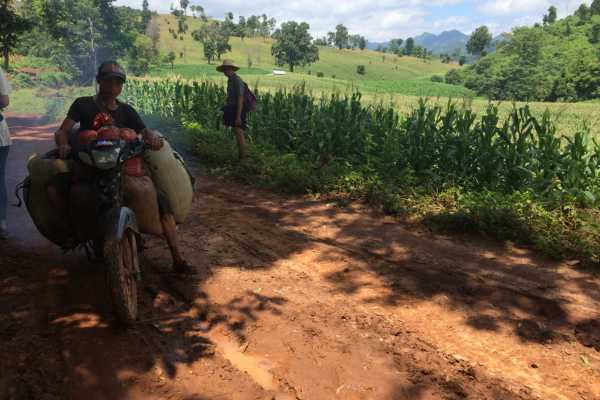
We head through a tea plantation – this is tea for domestic consumption only and for as an inclusion into the Burmese specialty, the tea leaf salad.
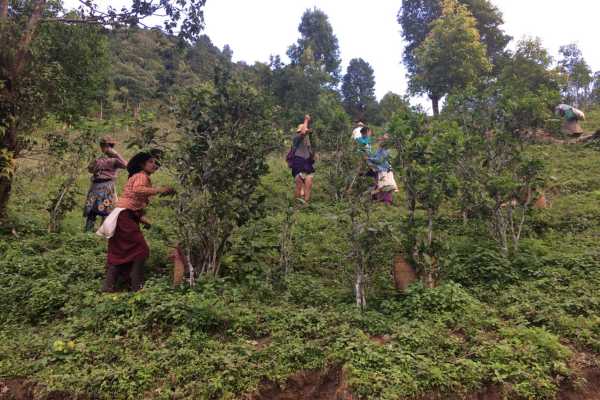
The plantation that we walk through belongs to the village and they all lend a hand in harvesting the tips.
Accomodation on our Shan State Trek
The village is a small place. Each couple has a room in the place we’ll stay tonight.
We’d expected to stay on a bamboo platform in a communal room, so this is a surprise- we each have a mattress on a platform, in a windowless room, with a huge mosquito net and a big thick duvet each (which we’ll need – the increase in altitude might have been small, but it’s significant – and LOVELY!).
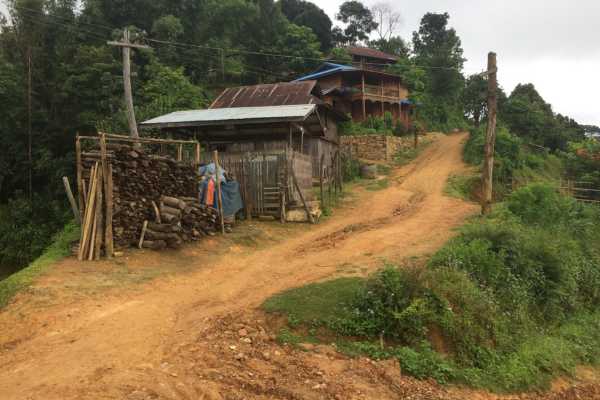
But it’s not bedtime yet, there are more Asian bamboo chairs to relax in and there is tea to drink.

The toilet is down the hill, you can see it in the photo, its one of those huts, perched high on a small platform over some vegetables (I don’t want to know), so we all find it in the daylight, as the sun has now gone and it’ll get dark very quickly here.
The path to the toilet is shared.

Dinner is similar to lunch – a series of vegetable dishes, this time with a clear river weed soup and endless rice.

Ellen is vegetarian and so Chris is by default, although he did admit to eating a sausage roll by accident the other day. I think that’s maybe how I ate Bacon while being vegetarian for so many years.
Conversation is animated, mostly by Sawmmy with tales of other treks he’s taken and I wonder what he’ll say about us, as I’m pretty sure that compared to those other folks we’ve been pretty boring! I’m sure that Sawmmy thinks so too, when after a single beer between each couple we head off to bed. More, in fear of repeated trips to the toilet perched on the edge of the abyss than anything else….
Where we’re staying appears to be the local 5am meeting point of the locals. Right outside our rooms.
Or perhaps its the “I’m up, so you should be too school of thought”. None of us move, though, until minutes before the appointed 07:30 breakfast, which includes a special treat. Hornets.
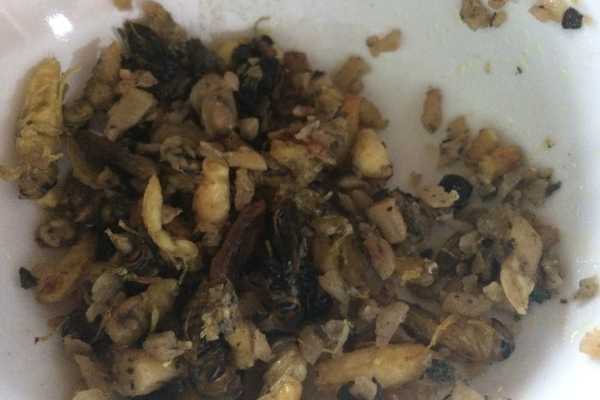
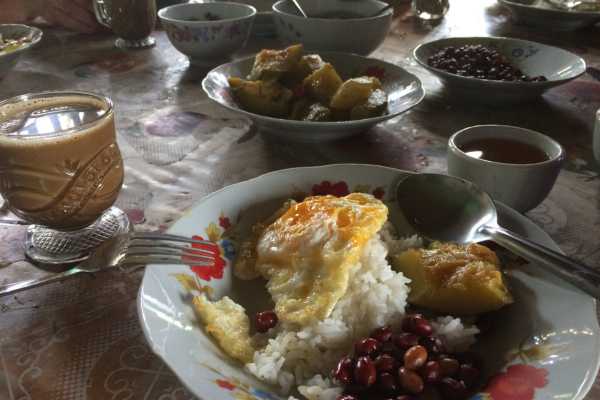
Everything, including pests, is eaten here.
But some combinations aren’t healthy, as Sawmmy takes delight in explaining to us – showing us a poster of food stuff that should not be eaten together, in case of cramps, diarrhea, shortness of breath, or death even.

On this basis I resolve never to eat Campbells cream of mushroom soup again, as cream and mushrooms cause problems.
Our return to Hsipaw follows some of the same route, but Sawmmy also takes us through woodland, and for regular rest stops.
The land here is incredibly fertile, three crops in a year in some fields. Much of the crop around here is grown for export to China, corn here is also grown for animal feed.

We also find sustenance en-route – Burmese acorns, which are surprisingly tasty..
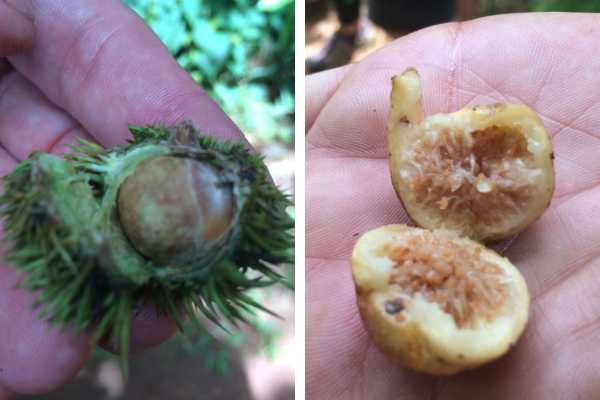
There’s some excitement on the way back. As we’re walking down the “logging road” Sawmmy motions us to a stop.
There’s a snake in the road. Yes, it’s poisonous. And it’s seriously, seriously green.

Normally, says Sawmmy, this snake lives in a tree and flies out.
Myanmar leads the world in the number of people who die from snakebites each year. This is usually because of the distance they have to travel to receive treatment.
We stick closely to Sawmmy for the rest of the trek.
We end the trek at a stream, where Sawmmy, carrying a spare set of clothes, jumps in and cools down – he’s hiked in a shirt and the traditional Burmese male longhi – 95% of folks that we meet in Myanmar wear traditional clothes, although Sawmmy does hike it up and double it over while he’s walking, which accounts for his tanned legs.

The four of us decide to wait for a shower back at the Lily Hotel.
It’s been a superb trek, the scenery is lovely here, the walking was easy – although it’s easy to see how it can get much harder quite quickly – and I’m glad we’ve hiked here – we saw two other groups for less than 10 minutes in our entire time on the trail. It really does feel as though we’ve had the Shan state to ourselves.

If you like hiking in off-the-beaten-track spots, then check out our guide to hiking Seoraksan and the Cloud bridge in Korea, as well as hiking in Sri Lanka here. And then for something truly spectacular, try the Rainbow mountains of Peru.
Travel Tips for Exploring Myanmar
- Get Travel Insurance: Civitatis includes medical expenses, repatriation, theft, luggage delays. No deductibles or upfront payments. Get a quote here.
- Download and install a VPN BEFORE you travel to Myanmar > discount coupon here
- Book Ferries, and Buses in Myanmar with 12goAsia
- Book accommodation in Myanmar with Agoda or Booking
Final Words on Our Trek in Shan State
We had a glorious time trekking in Shan State. At times it felt like we were the only people there at all. And it was glorious. There’s so much to see up here, so little infrastructure and it felt gorgeous to be out there in the villages, farmlands and tea plantations. If you get the chance this is a lovely part of the world.
ASocialNomad is a participant in the Amazon Services LLC Associates Program, an affiliate advertising program designed to provide a means for sites to earn advertising fees by advertising and linking to amazon.com, amazon.co.uk, and amazon.ca. Amazon and the Amazon logo are trademarks of Amazon.com, Inc. or its affiliates. As an Amazon Associate, I earn from qualifying purchases.


